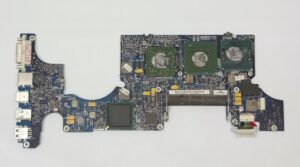Third Generation Language Meaning in English
Programming languages have evolved over the years, with each generation bringing new features and capabilities. Among these generations is the third generation language (3GL), which has played a crucial role in software development. In this article, we will explore the meaning of third-generation language in English and its significance in the programming world.
Key Takeaways
- Third generation language (3GL) is a high-level programming language that is closer to human-readable code.
- 3GLs enable programmers to write complex code efficiently, making it easier to develop software applications.
- Common examples of 3GLs include C, C++, Java, and Python.
- These languages provide greater abstraction and modularity compared to lower-level languages.
- 3GLs allow programmers to focus on problem-solving rather than low-level machine details.
Understanding Third Generation Language
**Third generation language (3GL)** refers to a class of high-level programming languages that are closer to human-readable code, making them more understandable and accessible to programmers. **These languages**, commonly known as procedural languages, are designed to simplify the development process and enhance productivity. Using **3GLs**, programmers can write complex code efficiently, resulting in the creation of sophisticated software applications.
Unlike lower-level languages such as assembly language, **third-generation languages** provide a higher level of **abstraction**. This means that programmers can focus on problem-solving and application logic rather than dealing with intricacies of the underlying hardware. *For example*, instead of writing machine-specific instructions, a programmer can use simple statements in a third-generation language to describe a complex set of operations, improving code readability and maintainability.
Examples of Third Generation Languages
There are numerous **third-generation languages** used in the development of software applications. Some popular examples include:
- C: Developed in the 1970s, **C** is a versatile language widely used for systems programming and the development of complex applications. It is known for its efficiency and ability to access low-level functionalities.
- C++: An extension of the **C** language, **C++** incorporates object-oriented programming (OOP) features, providing greater modularity and reusability. It is extensively employed in the creation of desktop applications, games, and system software.
- Java: **Java** is a portable, class-based language that gained popularity due to its platform independence and security features. It is widely used for developing web and enterprise applications.
- Python: Known for its simplicity and readability, **Python** has become one of the most widely-used programming languages. It is often used in scientific computing, data analysis, and web development.
Advantages and Disadvantages of Third Generation Languages
**Third-generation languages** offer several advantages over lower-level languages, making them highly preferred among programmers. Some of these advantages include:
- *Simplified syntax*: The syntax of **3GLs** is designed to be less complex and more human-friendly, making it easier to write and read code.
- *Portability*: **3GLs** are usually platform-independent, enabling programmers to develop applications that can run on different operating systems or hardware systems.
- *Greater productivity*: With a higher level of abstraction, **third-generation languages** allow programmers to develop applications more efficiently, reducing development time and efforts.
However, it’s important to note a few potential disadvantages of third-generation languages:
- *Learning curve*: While **3GLs** provide a high level of abstraction, they usually require more knowledge and understanding of programming concepts compared to lower-level languages.
- *Performance*: As **third-generation languages** introduce additional layers of abstraction and complexity, the resulting code might be less efficient in terms of speed or memory usage compared to lower-level languages.
Comparison of Different Language Generations
For a better understanding of third-generation languages, let’s take a look at a comparison of different language generations in terms of **abstraction level**, **code readability**, and **control over hardware**.
| Language Generation | Abstraction Level | Code Readability | Control Over Hardware |
|---|---|---|---|
| First Generation | Lowest | Very difficult to read | Complete control |
| Second Generation | Lower | Difficult to understand | Some control |
| Third Generation | Higher | Easier to read | Limited control |
| Fourth Generation | Higher | Highly readable | Little control |
Conclusion
In the world of programming, third-generation languages have played a vital role in simplifying software development. **These languages**, closer to human-readable code, have provided programmers with greater productivity and efficiency in creating complex applications. **From C to Python**, third-generation languages continue to evolve and shape the software development landscape, making programming more accessible and enjoyable.

Common Misconceptions
Third Generation Language Meaning in English
There are several common misconceptions that people often have when it comes to third-generation programming languages and their meaning in English. Clarifying these misconceptions can help in better understanding the topic:
- Third-generation languages have nothing to do with how many generations of computer technology there have been. It refers to a classification of programming languages based on their level of abstraction.
- Third-generation languages are not limited to one specific language. There are several popular third-generation languages, such as C, Pascal, and Java, each with their own strengths and weaknesses.
- The term “third-generation” does not imply that these languages are outdated or obsolete. In fact, third-generation languages are still widely used in modern programming, and many newer languages have built upon the concepts and principles of third-generation languages.
Contrary to popular belief, the “third” in third-generation languages does not indicate a hierarchical order. Here are some key points regarding this:
- The term “third” in third-generation languages represents the evolution from first-generation machine language and second-generation assembly language to a higher level of abstraction.
- Third-generation languages are designed to be more user-friendly and easier to read and write than previous generations, abstracting away the complexities of machine- or assembly-level code.
- Higher-level languages like third-generation languages enable programmers to focus more on problem-solving and logic rather than worrying about low-level details of the hardware.
Another misconception is that third-generation languages are solely used for application development. However, third-generation languages serve different purposes and can be used in various contexts:
- Third-generation languages can be used for system programming, including operating systems, device drivers, and embedded systems.
- These languages are also utilized in scientific computing for tasks such as simulations, data analysis, and modeling.
- With their versatility, third-generation languages are employed in web development, mobile app development, and enterprise software development.
To sum up, third-generation languages are much more diverse and contemporary than some might assume. Understanding the realities behind these common misconceptions can provide a clearer perspective on the significance and applications of third-generation programming languages.
- The term “third-generation” refers to the level of abstraction, not the chronological order of languages.
- Third-generation languages make programming more accessible and user-friendly.
- Third-generation languages are employed in a wide range of domains, including system programming, scientific computing, and application development.

The Evolution of Programming Languages
In the world of computer programming, languages have evolved significantly over time, from machine-level code to high-level languages that are easier for humans to understand and write. One significant milestone in this evolution is the development of third-generation languages (3GLs), which introduced more advanced features and improved programming efficiency. The following tables provide insights into different aspects of 3GLs and their impact on the field of computer science.
Table: Popularity of 3GLs
The popularity of different programming languages can vary over time. This table highlights the relative popularity of various third-generation languages based on developer usage statistics:
| Language | Popularity Rank |
|————|——————|
| Java | 1st |
| C++ | 2nd |
| Python | 3rd |
| JavaScript | 4th |
| C# | 5th |
Table: Features of a 3GL
A third-generation language provides developers with enhanced functionality compared to earlier language generations. This table illustrates some key features found in most 3GLs:
| Feature | Description |
|————————-|————————————————————–|
| Modular Programming | Allows code organization into reusable modules |
| Abstraction | Hides complex implementation details |
| Strong Typing | Enforces strict data type compatibility |
| Conditional Statements | Enables logical decision-making within the code |
| Looping Constructs | Provides iterative processes for code execution |
Table: Advantages of 3GLs
Third-generation languages offer several advantages that make them popular choices for software development. This table highlights some key benefits of using 3GLs:
| Advantage | Description |
|———————-|————————————————————–|
| Portability | Code can be easily adapted to run on different platforms |
| Readability | Syntax and structure are easier to understand and maintain |
| Reusability | Modules can be reused in different projects |
| Scalability | Applications can handle large datasets and increasing demands |
| Community Support | A large developer community provides resources and guidance |
Table: Example 3GL Statements
This table showcases some example code statements in popular third-generation languages:
| Language | Example Statement |
|————|—————————————————-|
| Java | System.out.println(“Hello, World!”); |
| C++ | cout << "Hello, World!" << endl; |
| Python | print("Hello, World!") |
| JavaScript | console.log("Hello, World!"); |
| C# | Console.WriteLine("Hello, World!"); |
Table: Popular Frameworks and Libraries for 3GLs
Third-generation languages often have a variety of frameworks and libraries available to simplify software development. This table presents some widely used frameworks and libraries for popular 3GLs:
| Language | Framework/Library |
|————|—————————————————|
| Java | Spring Framework, Hibernate |
| C++ | Qt, Boost |
| Python | Django, NumPy, TensorFlow |
| JavaScript | React, Angular, Express.js |
| C# | .NET Framework, ASP.NET, Entity Framework |
Table: Major Companies Using 3GLs
Many prominent companies rely on third-generation languages for their software development needs. This table lists some well-known companies that utilize 3GLs:
| Company | Primary 3GL Used |
|—————-|————————|
| Google | Python, Java |
| Microsoft | C#, JavaScript |
| Facebook | PHP, JavaScript |
| Amazon | Java, Python |
| Apple | Swift, Objective-C |
Table: 3GLs in Education
Third-generation languages play a crucial role in computer science education. This table provides information on universities that teach 3GLs as part of their curriculum:
| University | Featured 3GLs |
|——————|———————————————————————-|
| Stanford | Java, C++, Python |
| MIT | Python, C++, JavaScript |
| Harvard | Python, Java, C++ |
| Oxford | Java, Python, C++ |
| UC Berkeley | Python, Java, JavaScript |
Table: Job Opportunities for 3GL Developers
Proficiency in third-generation languages can lead to numerous job opportunities in the software industry. This table presents some popular job roles for 3GL developers:
| Job Role | Description |
|—————–|—————————————————————————–|
| Software Engineer | Design, develop, and maintain software applications |
| Web Developer | Create and maintain websites using 3GLs and web technologies |
| Data Analyst | Analyze and interpret complex datasets for companies and organizations |
| Systems Analyst | Analyze requirements and design software solutions for business systems |
| Game Developer | Create interactive video games using 3GLs and game development frameworks |
Table: Future Trends in 3GLs
The world of programming languages is ever-evolving, and 3GLs continue to develop and adapt to new challenges. This table presents some anticipated future trends in third-generation languages:
| Trend | Description |
|——————–|————————————————————–|
| Machine Learning | Integration of machine learning capabilities in 3GLs |
| Cloud Computing | Enhancements to facilitate cloud-based application development |
| Mobile App Development | Streamline 3GLs for building mobile applications |
| Internet of Things | Better support for developing applications for IoT devices |
| Functional Programming | Increased focus on functional programming paradigms |
Concluding paragraph: The evolution of programming languages has led to remarkable advancements in software development. Third-generation languages (3GLs) have played a vital role in shaping the industry, providing developers with powerful toolsets and improved efficiency. From their popularity and notable features to the benefits they offer and the job opportunities they create, 3GLs have revolutionized the way programs are written and executed. As technology progresses, it is exciting to anticipate how 3GLs will continue to evolve and adapt to meet the needs of future software development endeavors.
Frequently Asked Questions
What is a third generation language?
A third generation language (3GL) refers to high-level programming languages that are closer to human language and more user-friendly compared to earlier generations. These languages allow programmers to write instructions using commonly used words and phrases, making it easier to understand and write complex programs.
What are some examples of third generation languages?
Some examples of third generation languages include C, C++, Java, Python, FORTRAN, COBOL, and Pascal. These languages are widely used in various fields such as software development, data analysis, scientific research, and web development.
How is a third generation language different from earlier generations?
A third generation language differs from earlier generations, such as first and second generation languages, as they are closer to human language and provide higher-level abstractions. Earlier generations used low-level machine code or assembly language, which required more technical knowledge and were highly hardware-dependent.
What are the advantages of using a third generation language?
Using a third generation language offers several advantages, including improved programmer productivity, easier maintenance, greater portability, and better readability. These languages also provide built-in functions, libraries, and frameworks that simplify the development process and enhance code reusability.
Can third generation languages be used for any type of programming?
Yes, third generation languages can be used for a wide range of programming tasks. They are versatile and can be used for developing desktop applications, mobile apps, web applications, system software, game development, scientific simulations, and more.
Are third generation languages platform-specific?
No, third generation languages are generally designed to be platform-independent. They can be compiled or interpreted on different operating systems and hardware architectures, allowing the same code to be executed across multiple platforms.
Can third generation languages interact with low-level hardware?
Yes, third generation languages can interact with low-level hardware through the use of libraries, APIs (Application Programming Interfaces), and system calls. This enables programmers to control and utilize hardware resources such as memory, peripherals, and networks.
What skills are required to learn a third generation language?
To learn a third generation language, it is helpful to have a basic understanding of programming concepts and logic. Familiarity with algorithms, data structures, and problem-solving techniques can also aid in learning and effectively utilizing these languages.
How can I start learning a third generation language?
To start learning a third generation language, you can refer to online tutorials, documentation, and interactive coding platforms. There are also numerous books and courses available that cater to beginners and those with prior programming experience. It is recommended to practice coding and work on small projects to reinforce your understanding.
Are there any limitations of using third generation languages?
While third generation languages have many advantages, they also have some limitations. These include reduced execution speed compared to lower-level languages, limitations in hardware-specific optimizations, and a sometimes steeper learning curve compared to earlier generations for certain programming tasks.




